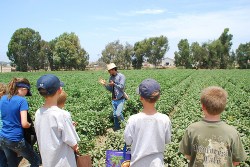
Suzie’s FarmChildren tour the 140-acre Suzie’s Farm in San Diego.
Environmentalists have grown used to thinking of urban agriculture as something that occurs on pinched vacant lots in former industrial towns. But as farms of 20 acres or more start appearing in more cities, their owners are reworking the definition of “urban farm,” and causing some agtivists to question whether bigger really is better.
In San Diego, there’s the 140-acre Suzie’s Farm. In Albuquerque, there is 40-acre Skarsgard Farms. Not only are both located within the city limits, they both grew more than $1 million in organic produce this season.
The success of such farms, combined with urban agriculture’s broad appeal, is inspiring city officials to consider dedicating large chunks of vacant land to farming.
In San Francisco, redevelopment plans for the former Navy base on Treasure Island include an “urban agriculture park” of more than 20 acres, according to Michael Tymoff, the project director. In Cleveland, a 26-acre farming district has taken root where houses once stood. In Kansas City, Mo., leaders are considering turning a 420-acre former prison, or some portion thereof, into a farm.
“We believe that there is room for both food system-related uses as well as more ‘traditional’ types of development” at the site, says Gerald Williams, a planner with the City of Kansas City. Depending on how much land Williams and his colleagues ultimately dedicate to agriculture, they may be building the biggest urban farm in the country.
The average American farm covers 418 acres, far more than the largest of its city counterparts. Yet the expanding footprint of farms in the urban core underscores people’s interest in the aesthetic of farming, as well as the rising market for local products and the abundance of vacant urban land.
Detroit’s Hantz Farms is still a modest operation, but its outsized ambition has created a controversy of equal proportions. Businessman John Hantz originally proposed a for-profit urban farm of 10,000 acres. But local outcry about the plan — including its size and Hantz’s low-ball offer for the land — forced him to downsize to a still-expansive 200 acres, which will be planted as a tree farm. The project’s website proclaims it both “the world’s largest urban farm” and “Detroit’s saving grace.”
The Hantz controversy highlights one of the most vexing questions about urban agriculture: How much land should cities properly devote to farming?
City halls nationwide find themselves emerging from the Great Recession with a lot of land to maintain. Urban farms and community gardens have become one of the most popular options.
The problem is, many small urban farmers are tired of being told their work is symbolic and are eager to grow the amount of food that will bring in a profit. That’s the idea behind Cleveland’s Urban Agriculture Innovation Zone, which shelters not one large farm but many small ones: 15 half-acre incubator plots — fostering 15 new businesses — plus five “anchor” farms ranging from half an acre to four acres.
“If we had another 20 spots, we could fill them,” says Marie Barni, who oversees the zone on behalf of the Ohio State University Extension. Barni and her team are reviewing applications from would-be farmers, with the hope that, after a few years in the incubator, they will grow up and move out like fledged chicks. Logically, the project is funded in part by the USDA’s Beginning Farmer and Rancher Development Program.
Small urban farms can quickly become enormous ones. As Monte Skarsgard says of his capacious Albuquerque range: “Besides the machinery, what we do isn’t much different than a scaled-up one-acre farm. The key is to finding the right combination of intensive crops to make the higher land costs in the city worth it.”
Yet more than a few environmentalists have argued that urban farms must remain small or risk suburbanizing the city. One of the most prominent is Kaid Benfield, a smart-growth guru with the Natural Resources Defense Council. Benfield worries that urban farming, if practiced on a large scale, will dilute the walkability and density that defines cities.
“I support the growing of food in cities, and have even done it myself,” Benfield cautions. “But it should be done in ways that support urbanism and not displace it.”
“I’m not sure we’re talking about a city any more if we’re going to have fields of 20 acres and more.”
By seeding large farms in the city, he says, “we risk locking in long-term environmental problems in terms of not having a healthy urban core. Central cities are starting to revive.”
One problem is that most of the best para-urban land (or land just outside cities) — which was once seen as ideal for growing food without huge transportation costs — has already been swallowed up by suburban development.
Some would argue that there’s no way these large farms can last, given our nation’s history of boom and bust economic cycles. On a related note, Robin Shulman, author of Eat the City, said in a recent Grist interview, “… even in New York and San Francisco, [land availability] has crested and fallen again in direct relation to the economy. It’s a pattern that has happened repeatedly since the late 1800s. Whenever there’s an economic fall, people use the space where other buildings were to produce food to feed those who are hungry.”
According to Benfield, “once urban land is made green, it’s going to become loved as green rather than loved as city.” Not that we can blame anyone for loving green space. But that’s where sticking to smaller, truly sustainably sized farms in cities — and leaving the bulk of our food production to rural areas — might make the most sense. It will also save us all the heartbreak of seeing our favorite crops plowed under too soon.
Research for this article was supported by a grant from the Fund for Environmental Journalism.




